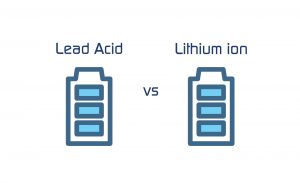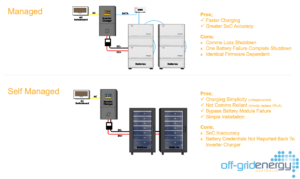

Looking into your options for an off-grid energy system can quickly become a steep learning curve into the world of electricity. Here’s a guide to some commonly used terms and abbreviations, and what they mean.
A = Amp
A measurement of the rate of electrical flow in a circuit (a component of power)
V = Volt
A measurement of electrical pressure across two parts of a circuit (a component of power)
W = Watt
A measurement of instantaneous power. Volt x Amp = Watt
kW = Kilowatt
A measurement of true instantaneous power; 1000 Watts make a Kilowatt
kVA = Kilo Volt Amp
A measurement of apparent power before it is corrected for current and voltage waveform misalignment (power factor or pf) to make it true power or Kilowatts.
Ah = Amp hour
The product of multiplying amps and hours; often used to measure the current delivery capacity of battery banks at a specific discharge rate and time period such as 20 or 100 hours etc. (It is only a component part of energy)
Wh = Watt hour
A measurement of energy; it means watts delivered, calculated over a one hour period.
kWh = Kilowatt hour
A measurement of energy that is often used for billing purposes for example; it means Kilowatts delivered, calculated over a one hour period. A Kilowatt hour is the product of Volt x Amps x Hours x 1000. One Kilowatt hour = 1000 watt hours. Kilowatt hours are sometimes used to measure battery energy storage capacity; it is calculated by multiplying Amp hours by the battery bank nominal voltage.
kWh Storage
This relates to energy storage capacity. If you have a battery with a storage capacity of 5 kWh, it means that the battery can store up to 5 kilowatt-hours of energy.
kWh Consumption
This refers to the total amount of energy consumed over a period of time, measured in kilowatt-hours (kWh). If you have a device with a power rating of 1 kW (1000 W) and it operates for 1 hour, it will consume 1 kWh of energy.
When discussing solar energy systems, “kW” refers to the power rating of the solar panels, which indicates how much power they can generate under optimal conditions. “kWh” refers to the amount of energy produced by the solar panels over a period of time.
For example, if your solar panel system produces 5kW of power consistently for 1 hour, that’s 5 kWh of energy (5 kW x 1 hour = 5 kWh).
LV = Low voltage class
Includes mains power and is applicable to all equipment operating above 120 Volts DC or 50 Volts AC and not exceeding 1000 Volts AC or 1500 Volts DC. LV class equipment can only be serviced by a licenced electrician.
ELV = Extra Low voltage
This voltage is typically used in battery banks. ELV class applies to electrical equipment operating below 120 Volts DC or 50 Volts AC
DC = Direct Current
Refers to a current that flows in only one direction.
AC = Alternating Current
Refers to a system utilising a current that rapidly flows back and forth; for mains power equipment the current typically runs back and forth at 50 times per second.
AC-Coupled
AC coupling refers to a configuration where the renewable energy source, such as solar panels, is connected to the off-grid system through an inverter. In this setup, the solar panels produce direct current (DC) electricity, which is converted into alternating current (AC) electricity by the inverter. The AC power generated by the inverter is then used to supply the electrical loads or charge the battery bank.
DC-Coupled
DC coupling, on the other hand, involves connecting the renewable energy source directly to the battery bank without converting the generated DC power into AC power. In this setup, the solar panels or other renewable sources charge the battery bank directly.
Hz = Hertz
This is the name given to the measurement of frequency of alternating current cycles per second. Regarding generators the frequency in Hertz usually relates directly to engine speed.
M.P.P.T. = Maximum Power Point Tracking
This is an advanced method of extracting the maximum possible power from a solar array (usually) within the solar inverter or solar charge controller as opposed to older type basic regulators which do not have this feature.
SoC = State of Charge
State of Charge refers to the amount of energy stored in a battery compared to its maximum capacity. It is usually expressed as a percentage, where 0% represents completely discharged, and 100% represents fully charged. Monitoring SoC is important for managing the usage and charging of the battery to prevent overcharging or deep discharging.
DoD = Depth of Discharge
Depth of Discharge refers to the percentage of energy that has been withdrawn from a battery compared to its total capacity. Batteries that are frequently discharged to a high DoD may experience accelerated wear and reduced performance over time.




Many of today’s off-grid homes are just as comfortable and feature-packed as their mains-powered counterparts.

Single Wire Earth Return (SWER) lines have been a cornerstone of rural electricity distribution for decades. Designed to provide power to remote and sparsely populated

Whether you’re connected to the grid or want to go completely off-grid, it’s important to understand which battery type fits your needs, lifestyle, and budget.

Before explaining the differences, it’s useful to understand that all lithium batteries need a battery management system (BMS) of some kind.
Off-Grid Energy Australia · Securing your power and your future
Electrical Contractor Licenses: VIC REC-31913, TAS 15608294, WA EC15901, SA PGE278927, NSW 279181C